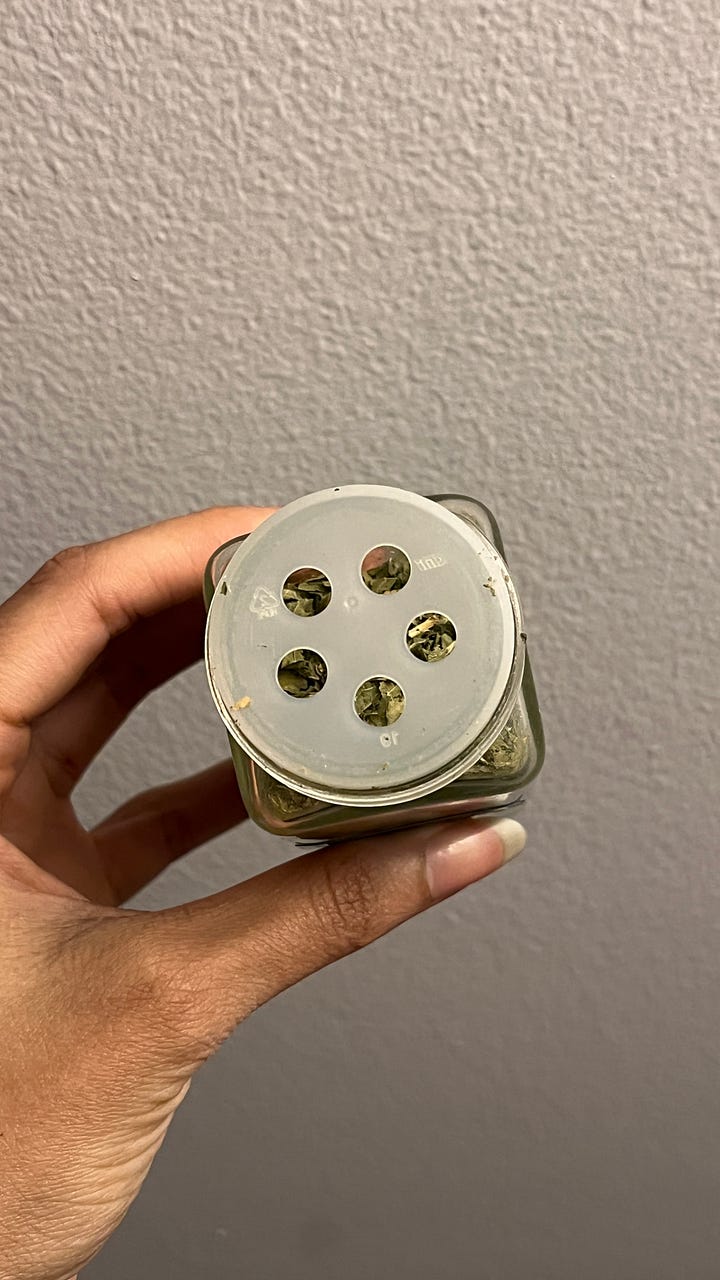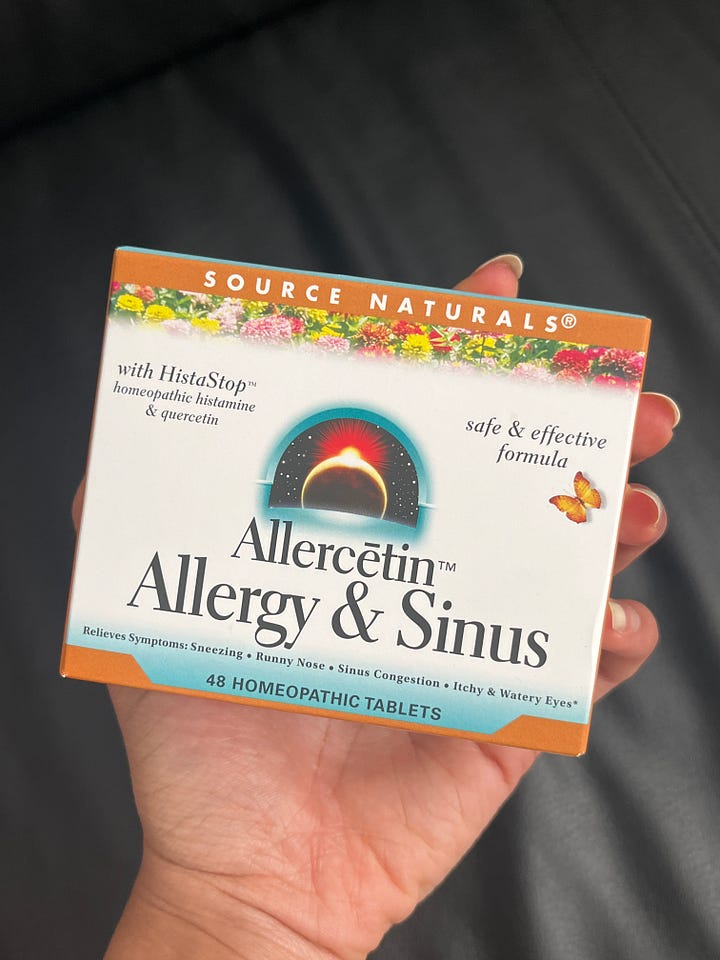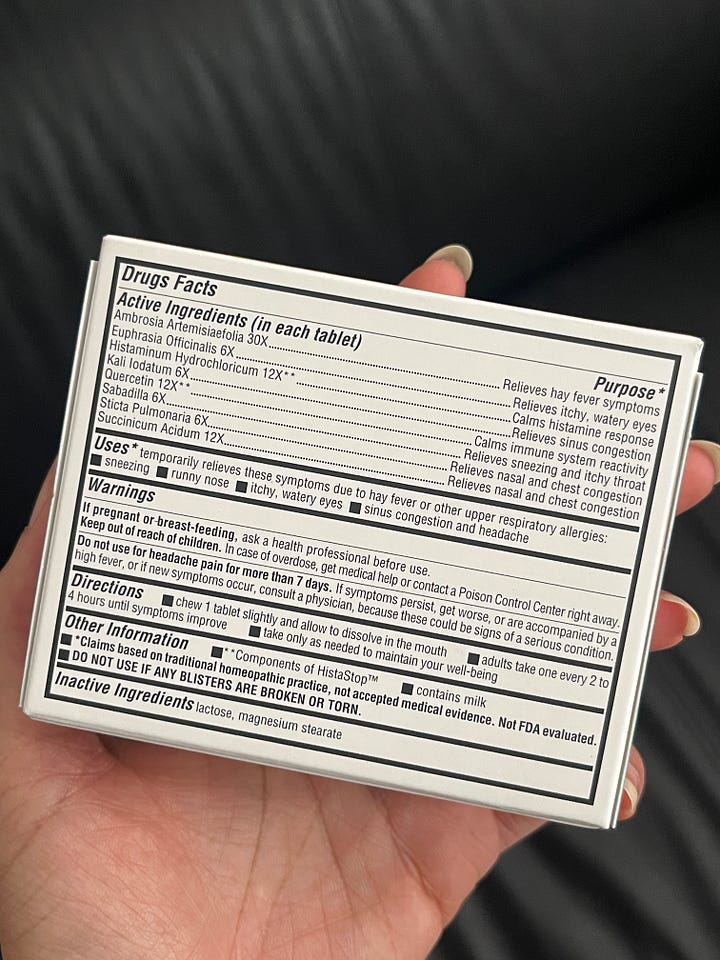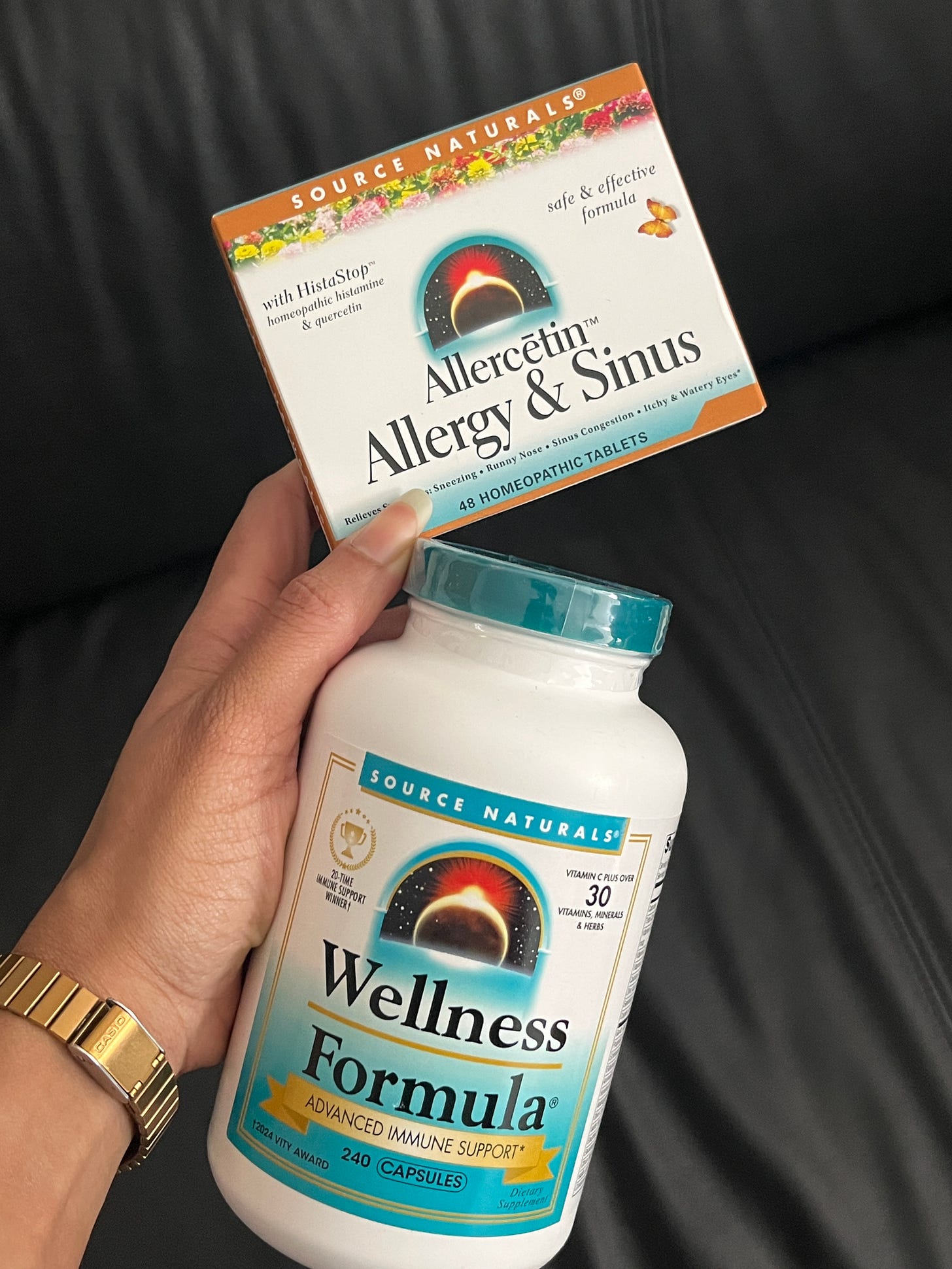How I'm preparing for allergy season
Recommendations from my kitchen apothecary and toolkit for managing and reducing allergy symptoms
This post contains affiliate links. Click here to read about my policy for brand partnerships and affiliations.
Spring (and allergy season) is among us!
I was one of the few lucky ones growing up who did not suffer from seasonal allergies, however when I moved to Philadelphia for college years back, I was introduced to new sources of pollen in the environment that spurred nuisance allergy symptoms, like a tickly throat, itchy nose, and more.
In this post, I’m going to share a few tools in my kitchen apothecary that I’m equipping to support me during this seasonal transition.
Natural Antihistamine Support
Histamine is the culprit
When we are faced with allergens and pollutants, our immune systems’ mast cells release histamine, which are responsible for the flare ups in symptoms one gets when triggered by allergens—whether they are seasonal or sourced from foods like shellfish. Our body detoxes histamine through our liver and gut, and when our liver and gut are sluggish or not working optimally, we can see an overload of histamine in the body. This results in allergy symptoms, including adverse reactions to both airborne and food allergens.
For women, high histamine levels are also associated with high levels of estrogen. The two instigate the overproduction of one another in the body when their levels are not under control. Women, like myself, who navigate estrogen dominance (think PMS symptoms, sore breasts, painful periods) would benefit from understanding histamine’s role in hormonal balance and being intentional about keeping levels under control.
Histamine can be naturally occurring, and many nutrient-dense foods are common sources of histamine, including some of my favorites like bone broth, shellfish, and cheese. It can also be present in leftovers and tinned food like beans and fish. While keeping these foods in the diet are ideal for optimal health, I’m going to share some things I utilize in order to mitigate histamine, especially during peak allergy season.
Nettle Leaf
Stinging nettle is a natural antihistamine, rich in chlorophyll and a variety of plant-based vitamins and nutrients. I wrote a bit about its benefits here:
Nettle has been a mainstay in my kitchen apothecary since I was college, and it always makes its way into my weekly herbal infusions. Brewing and drinking nettle leaf as a tea or infusion and drinking daily can be a great way to reduce histamine activity and support you throughout allergy season. I prefer to buy my herbs in bulk, so I always keep a large bag and jar of loose leaf nettle on hand, which runs for an economical $19 per a pound of nettle leaf (which is a LOT, and will last you a long time!)
However here are some other options for if you would like to get your hands onto some nettle for this spring:
Frontier Co-Op now sells smaller bags of their popular loose leaf herbs, and you can buy an ounce of loose nettle leaf for about $3
If you want to go for it, you can shop their one pound bulk bag for $19
If you prefer tea bags, I highly recommend the Traditional Medicinals brand, which is high quality and minimizes bleach and microplastics in their bags
It tastes a bit grassy and can take some getting used to, but tastes great blended with other herbs or with a bit of lemon juice and honey when drank hot, or apple cider vinegar added to a cold infusion.
⇢ Tip! Add some loose leaf nettle to an empty spice jar and use it in your kitchen the way you would use dried parsley or any other green herb. Add to salads, poultry and meat rubs, and more!


I often get my herbs and supplements from iHerb. You can use my code KEN8980 for 5% off every order and enjoy free expedited shipping on orders over $30.
Reishi
Reishi is a kind of mushroom native to Asia that has been used for immune health and general wellness for centuries. For allergy support, it provides anti-inflammatory support and can assist the immune system in balancing TH1 and TH2 immune responses. While our bodies need both, reishi’s properties can help to optimize the TH1 immune state, which are implicated in cell-mediated immunity (“a cleanup” reaction that rounds up and disposes of allergens) rather than yielding to a TH2 immune response, which is responsible for antibody production and allergic reactions (which we do not want too much of!)
How to consume it:
In powder form (I recommend Frontier Co-Op, Terrasoul Superfoods or Om Mushrooms) which can be added to smoothies and lattes
In capsule form (Om Mushrooms is highly recommended)
As a tincture (I love Rainbo for my mushroom tinctures, and they sell tasty non-alcoholic options extracted in organic vegetable glycerin)
As a decocted herbal infusion, by simmering about 5-10g of dried reishi mushroom to a quart of water—it’s bitter (which helps stimulate digestion!), but can be enjoyed sweetened with red jujube dates, licorice root, and/or honey and pairs well with ginger and Ceylon cinnamon
When supplementing with mushrooms, you want to ensure that you are getting high quality sources. Look out when shopping for mushroom supplements. Be sure to avoid those with nutrition panels and ingredients lists that only cite “mycelium” as the part of the mushroom used in the supplement, or ones that are cut with the biomass, like myceliated oats or rice as filler. The mycelium and biomass are merely the root structure and base that the mushrooms were grown on, respectively, and you want to be consuming the fruiting body in order to really feel the benefits.
Quercetin
Quercetin is a bioflavonoid antioxidant that supports the immune system and is especially useful for disarming histamine in the body.
Some strong food sources of Quercetin include:
Onion (especially red) — use raw in salads, on burgers, or sautéed and cooked into warm meals
Capers — great with fish and salads, like nicoise
Dill — add to dressings, salad, fish, potatoes
Watercress — a leafy green that tastes great lightly sauteed with garlic or added raw to salads
Kale and other leafy greens — enjoy in salads, massage with olive oil or lightly stir fry for detoxifying insoluble fiber
Asparagus — another great source of fiber as well, to help keep things moving in the digestive tract: steam and enjoy with olive oil and lemon juice
Fruits and fruit juices like grapes, cherries, cranberries, and other berries
Quercetin can also be supplemented with when you are in need of a more therapeutic dose to combat histamine flares and allergies. I like to keep Source Naturals Quercetin NutraDrops on-hand to take daily during this season and other times when my body could use more significant support.
I find that this liquid form of quercetin from Source Naturals is easy to take. I like to buy a 4 oz bottle from iHerb which is pretty economical, and Amazon sells a 2 oz bottle which is on sale for 20% off through April 1st, 2025!
DAO Enzymes
Diamine oxidase or DAO is a digestive enzyme of which its primary function is to break down histamine through metabolism, oxidation, and inactivation of histamine through the digestive system. It’s comprised of vitamin C and copper, and it uses vitamin B6 to help it to break down histamine. You can support DAO metabolism by incorporating foods rich in the three nutrients in your diet:
For vitamin B6, eat chicken breast, salmon, beef, bananas and/or supplement with a high quality, methylated B vitamin complex (Moon Juice’s Ting is my favorite)
For vitamin C (and copper as they are often found together): bell peppers, kiwi, citrus, and more
For copper: Eat beef liver, oysters, shiitake mushrooms, sweet potatoes, cashews, sesame seeds, and bee pollen
DAO can be supplemented and can also be sourced from offal/meat organs, primarily beef kidney.
I have personally been taking Heart & Soil’s Histamine & Immune formula which contains a blend of beef kidney and other organs to break down and inactivate histamine. I like that Heart & Soil’s supplements are sourced from grass-fed, nutrient-dense beef organs, and find that 3 capsules of this formula daily along with my other habits have been working well for me.
You can use my link for 20% off your Heart & Soil order. The supplements in their store are also FSA/HSA eligible through TrueMed!
Supporting DAO enzyme production through diet and supplementing with DAO has been an absolute game-changer for me in helping to reduce histamine. I don’t have to miss out on otherwise good-for-you foods that can be high in histamines, like shellfish, fermented yogurt, kimchi, sauerkraut, and miso, tinned fish, bone broth, and more—nourishing my body with whole foods nutrients.
Honey
Local honey is made by bees from the pollen of flora local to your regional environment. Consuming honey made regionally to where you are located can help your body to build familiarity, immunity, and resilience to allergens. You can find local honey at farmers markets, health and grocery stores. I like to pick up the Local Hive brand from my local grocery stores, as they specialize in cultivating local varieties of honey for different regions. Being from New Jersey, based in Philly, and traveling frequently through the Mid-Atlantic for work, I either use their Northeast or Mid-Atlantic region honey.
Nutrition
Eating seasonally is one of the best ways we can support our bodies nutritionally. While I already covered some of the foods sources of quercetin and antihistamine support, here are some other foods to incorporate this season:
Bitter greens like arugula, dandelion, mustards, and radicchio provide fiber and stimulate bile production for optimum digestion and clearance of histamine and other toxins, and are also liver-supportive
Salmon, cod, sardines, mackerel, and seaweed provide sources of iodine, B vitamins, and antioxidant omega-3 fatty acids that protect the liver
Seasonal fruits and veggies like strawberries, apples, blood and cara cara oranges, artichokes, beets, artichokes, and carrots are rich in antioxidants, soluble and insoluble fiber (think pre-biotics to feed healthy gut bacteria and motility support to keep things moving), vitamin C, and more
Symptom Relief
Here are a few tools I like to keep on hand for symptom relief and general immune support:
Immune Support
Source Naturals Advanced Immune Support is my go-to for combating any symptoms of illness, allergies, and inflammation in my body―I don’t take this daily, but it’s what I keep on hand when my body needs an extra boost.
Cod Liver Oil is one of the best, bioavailable (readily absorbable) sources of vitamins A and D which are absolutely essential for immune wellness. I recently started supplementing with capsules to ensure bioavailability of these nutrients to support my body’s immune response. This palatable liquid format looks great, too.
Allergy Symptom Relief


Homeopathy works by stimulating your body’s immune system and natural defenses against ailment. Source Naturals Allercētin Allergy & Sinus Homeopathy Formula is a safe, drug-free, effective alternative to over-the-counter medications like Zyrtec and Benadryl. These OTC allergy medications are band-aid solutions that merely cover up systems rather than working synergistically with your body to improve resilience in the face of allergens. Both drowsy and non-drowsy OTC formulas have also been shown to decrease cognition and slow you down, so they are not the best bet to rely on for long-term use. Allercētin in contrast incorporates homeopathic doses of both quercetin and histamine in order to activate your body’s antihistamine response.
Support drainage in the body with gua sha and face massage to relieve congested lymph and sinuses―use your favorite face and body oil and your hands or a gua sha tool to support movement and help your body to dispel inflammation, congestion by massaging swollen glands and sinuses.
Nasal rinses are superb for clearing your airways and sinuses from pollen and other allergens or irritants in the air (think dust or powders). I make my own saline solution at home by combining a ratio of 4 tbsps non-iodized salt (I used Redmond salt) and 1.5 tbsps of baking soda and blending it in a coffee grinder or blender to get an evenly distributed powder. I then add about half of a teaspoon of this solution blend to distilled or filter warm water in a porcelain Neti Pot. You can also grab a Neti Pot or nasal irrigator at your nearest pharmacy (CVS, Walgreens), Whole Foods, etc.
Stay well this season!
Yours in nourishment,
Liked what you saw here? Follow garlic and dyl on Instagram for more holistic wellness.


















Love this!